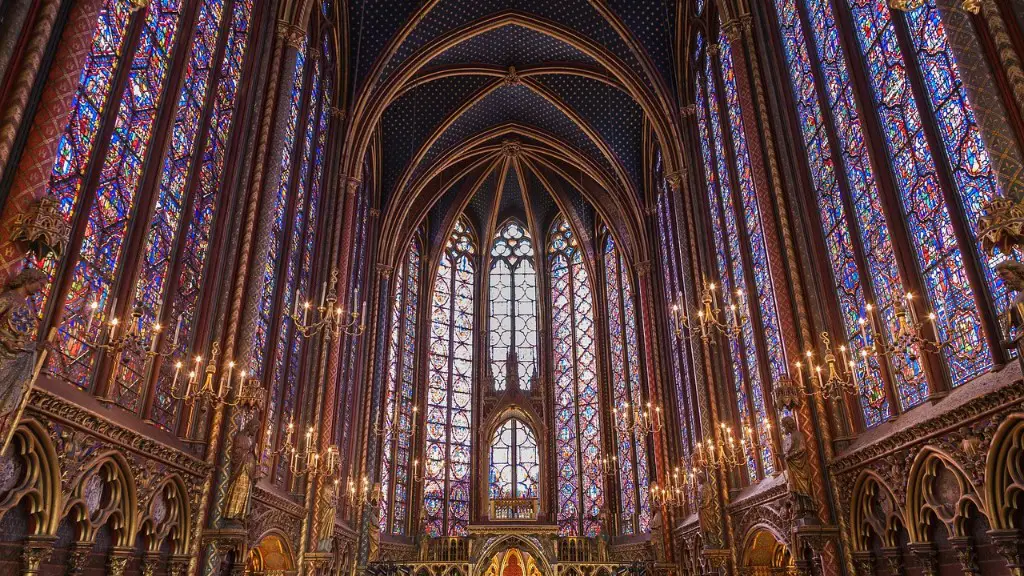Gothic architecture is a European style of architecture that flourished during the High and Late Middle Ages. It evolved from Romanesque architecture and was succeeded by Renaissance architecture. Originating in 12th century France and lasting into the 16th century, Gothic architecture was known during the period as opus Francigenum (“French work”), with the term Gothic first appearing during the latter part of the Renaissance.
The word “gothic” is derived from the Gothic tribes who inhabited much of Europe during the Middle Ages. Gothic architecture is characterized by its pointed arches, ribbed vaults, and flying buttresses.
Where did the Gothic architecture originate?
The Gothic style of architecture first originated in the Île-de-France and Picardy regions of northern France during the medieval period. The style at the time was sometimes known as opus Francigenum (lit ‘French work’); the term Gothic was first applied contemptuously during the later Renaissance, by those ambitious to revive the architecture of classical antiquity. Gothic architecture was characterized by its ornate and intricate designs, often featuring pointed arches and ribbed vaults. The style continued to spread throughout Europe, and by the 13th century, it had become one of the most prevalent architectural styles in the continent.
The Gothic style originated in 12th-century CE France in a suburb north of Paris, conceived of by Abbot Suger (1081-1151 CE). Abbot Suger was a powerful figure in French history and the mastermind behind the first-ever Gothic cathedral, the Basilica of Saint-Denis. The Gothic style is characterized by its pointed arches and ribbed vaults, which allowed for taller and more spacious buildings. The style quickly spread throughout Europe and became the dominant architectural style for centuries.
What was Gothic architecture influenced by
The Gothic style of architecture emerged in the 12th century and was greatly influenced by the Romanesque architecture that came before it. This new style was also a result of the growing population and wealth of European cities during this time, as well as the desire of many to create grand and impressive structures. Gothic architecture is characterized by its pointed arches, ribbed vaults, and flying buttresses, and has had a lasting impact on the architectural world.
Gothic architecture is a prominent and defining feature of Germany’s architectural history. The painting and sculpture associated with these Gothic buildings often offer important insights into the medieval period. Gothic architecture is characterized by its ornate, dramatic style, which often features intricate details and tall spires. Gothic architecture first emerged in the 12th century and reached its peak in the 13th and 14th centuries. Many of Germany’s most famous and iconic buildings, such as Cologne Cathedral and Berlin Cathedral, are Gothic in style. Gothic architecture continues to be popular in Germany today, and new Gothic buildings are still being constructed.
When did Gothic style originated?
The 12th century saw the rise of the Gothic style of architecture and art. This style was characterized by high buildings, intricate aesthetics, cavernous spaces, and expansive walls. It was prevalent in Europe between the mid-12th century and the 16th century.
Gothic architecture is a style of masonry building that originated in Europe in the mid-12th century. It is characterized by cavernous spaces with the expanse of walls broken up by overlaid tracery. Gothic architecture lasted until the 16th century, when it was replaced by Renaissance architecture.
Why was the Gothic style created?
Gothic design is a type of architecture that emerged in the 12th century and was popular until the 16th century. It is characterized by its pointed arches, ribbed vaults, and flying buttresses. Gothic design was actually created to bring more sunlight into spaces, mainly churches, and led to the design and construction of some of the world’s most iconic buildings.
The term Gothic is used to describe a style of architecture that was popular in the Middle Ages. This style is characterized by its pointed arches and ribbed vaults, which were used to help support the weight of the building. Gothic architecture was used in a variety of settings, including churches, castles, and other public buildings.
What is the origin of Gothic art
Gothic art was characterized by an increased emphasis on realism and the use of light and shadow to create a more three-dimensional effect. Gothic art is often associated with the Gothic architecture, which also developed during this period. Gothic art is also sometimes referred to as Romanesque art, due to the similarities between the two styles. Gothic art typically include stone carvings, paintings, and intricate metalwork.
Gothic architecture is a style of architecture that began in the 12th century and lasted until the 16th century. Gothic architecture is characterized by its ribbed vaults, pointed arches, and elaborate stone carvings. Many Gothic buildings were inspired by nature, with columns that sprouted leafy capitals and vines that twisted along screens. Humanity also had its place in Gothic architecture, with statues ornamenting façades and corbels carved with human heads. The ribbed vault in Durham Cathedral was one of the first examples of Gothic architecture, and was completed as early as 1133.
Did Gothic architecture come from the Goths?
It is often assumed that there is a relationship between the Visigoths and Gothic architecture, but there is no evidence to support this claim. The main influences of Gothic architecture were the Byzantine and Romanesque styles.
Gothic architecture is characterized by its pointed arches, rib vaults, buttresses, and extensive use of stained glass. These features allowed for the creation of taller and more grandiose buildings, filled with light from large windows. Gothic architecture reached its peak in the High and Late Middle Ages, and has since been revived in various forms.
Which country is the most Gothic
Gothic architecture is a European style of architecture that began in the 12th century. Gothic architecture is characterized by its pointed arches, ribbed vaults, and flying buttresses. The signature Gothic style originated in France, but the architectural movement quickly spread across Europe, especially in Italy, Spain, Germany, and Britain. Some of the best Gothic architecture examples can be seen in France, one of the earliest being the Basilica of Saint-Denis in Paris completed in 1144 CE.
Gothic architecture is known for its ornate and intricate designs. This style of architecture originated in 12th century France and lasted until the 16th century. Gothic architecture was initially known as “Frankish work”. However, the term “Gothic” became more commonly used during the Renaissance period. Gothic architecture is characterized by its pointed arches, ribbed vaults, and flying buttresses.
Did Gothic architecture begin in Germany?
Gothic architecture is a style of architecture that began in France during the 12th century. It then spread into Germany during the 13th century and became more widely known across northern Europe. Gothic architecture is characterized by its pointed arches, ribbed vaults, and flying buttresses.
The gothic style is characterized by its ornate and dramatic features, which were designed to reflect the grandeur of the divine. Gothic buildings were often constructed with the intention of housing sacred relics or providing a space for religious rituals. For centuries, the gothic style was synonymous with spirituality and piety. Today, the gothic style is still revered for its majesty and beauty, and continues to inspire awe in those who behold it.
What was Gothic style originally called
Gothic architecture is a style of architecture that originated in France in the mid-12th century. It is characterized by its use of the pointed arch, rib vaults, and flying buttresses. Gothic architecture was used in the construction of cathedrals, castles, and other large religious and secular buildings.
Abbot Suger was the abbot of the monastery at Saint-Denis in France during the 12th century. He is best known for his reconstruction of the abbey church at Saint-Denis, which is considered to be the first Gothic church. Abbot Suger was also a major patron of the arts, and his patronage helped to spread Gothic architecture throughout Europe.
Warp Up
The term “Gothic architecture” originated in the 12th century, when Europeans began to refer to the pointed arches, ribbed vaults, and flying buttresses of their newly constructed cathedrals as being of “Gothic” style. This style of architecture had its roots in the Romanesque architecture of the previous century, but its popularity quickly spread across Europe, eventually reaching as far as Russia. Gothic architecture is characterized by its pointed arches, often decorated with ribbed vaults and/or flying buttresses. Gothic cathedrals are also often noted for their large size and grandiose designs.
Gothic architecture began in 12th-century France and spread throughout Europe. Gothic architecture is characterized by its pointed arches, ribbed vaults, and flying buttresses. Gothic architects also increased the size of windows to allow more light into the building.





